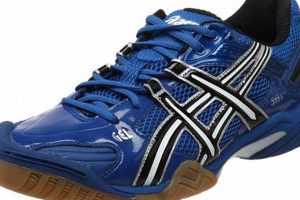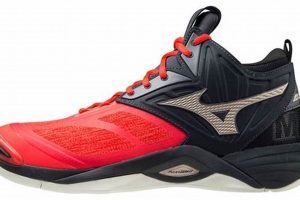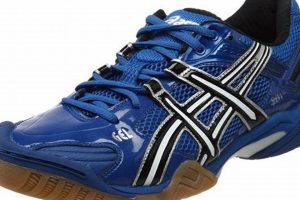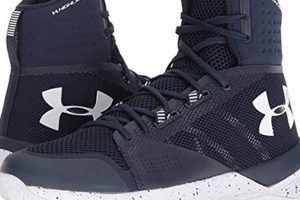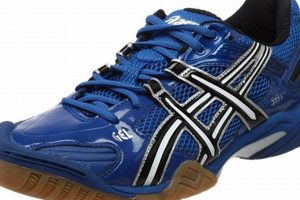In the intense and exhilarating world of volleyball, having the best footwear can make all the difference between victory and defeat. With countless options available, finding the best volleyball shoes for men can be a daunting task.
Editor’s Note:Choosing the best volleyball shoes for men is crucial for maximizing performance, preventing injuries, and enhancing overall gameplay.
Through extensive research, analysis, and expert insights, we have compiled this comprehensive guide to help you make an informed decision and elevate your volleyball game to new heights.
Key Differences:
| Feature | Low-Top Shoes | Mid-Top Shoes | High-Top Shoes |
|---|---|---|---|
| Ankle Support | Least Support | Moderate Support | Most Support |
| Flexibility | Most Flexible | Moderately Flexible | Least Flexible |
| Cushioning | Less Cushioning | Moderate Cushioning | Most Cushioning |
Main Article Topics:
- Types of Volleyball Shoes: Low-Top, Mid-Top, and High-Top
- Essential Features to Consider: Cushioning, Ankle Support, and Fit
- Top Brands and Models: Nike, Adidas, Asics, and Mizuno
- Tips for Choosing the Right Shoes: Consider Playing Style and Court Surface
- Maintenance and Care: Tips for Extending Shoe Lifespan
1. Cushioning
In the demanding sport of volleyball, players constantly engage in high-impact movements such as jumping, landing, and quick lateral changes of direction. Cushioning in volleyball shoes plays a crucial role in mitigating the shock and impact forces associated with these movements, ensuring comfort and reducing the risk of injuries.
- Impact Absorption: Cushioning materials, such as EVA foam or gel, absorb the generated upon landing and jumping, protecting the feet, joints, and lower body from excessive stress.
- Energy Return: Advanced cushioning systems not only absorb impact but also provide energy return, propelling players forward and enhancing their overall performance.
- Comfort and Support: Adequate cushioning ensures a comfortable fit, preventing blisters, foot pain, and fatigue during extended periods of play.
- Injury Prevention: By reducing shock and impact forces, cushioning helps prevent common volleyball injuries such as plantar fasciitis, heel spurs, and stress fractures.
The level of cushioning required in volleyball shoes depends on factors such as playing style, court surface, and individual preferences. Players who engage in frequent jumping and high-impact movements may opt for shoes with maximum cushioning, while those prioritizing agility and flexibility may prefer shoes with moderate cushioning.
2. Ankle Support
In the dynamic and physically demanding sport of volleyball, ankle support plays a pivotal role in ensuring player safety and performance. Volleyball shoes designed with optimal ankle support offer numerous benefits, making them essential for both professional and recreational players.
- Injury Prevention: High-top or mid-top volleyball shoes provide enhanced ankle stability, reducing the risk of sprains, strains, and other ankle injuries that can sideline players for extended periods.
- Improved Agility and Balance: Stable ankles allow players to move with greater confidence and agility, enabling quick changes of direction and improved balance during jumps and landings.
- Enhanced Performance: With secure and supported ankles, players can focus on their performance without worrying about ankle pain or instability, leading to improved overall gameplay.
- Reduced Fatigue: Well-supported ankles reduce muscle fatigue, allowing players to perform at their best for longer durations.
The level of ankle support required in volleyball shoes varies depending on individual playing style, court surface, and injury history. Players with a history of ankle injuries or those who play on uneven surfaces may benefit from high-top shoes with maximum ankle support. Conversely, players who prioritize flexibility and mobility may prefer low-top shoes with less ankle coverage.
3. Fit
In the demanding and dynamic sport of volleyball, a well-fitting pair of shoes is essential for optimal performance and injury prevention. Proper fit ensures a snug and secure connection between the foot and the shoe, eliminating excessive movement and discomfort that can hinder gameplay.
- Blister Prevention: A snug fit minimizes friction and rubbing against the skin, reducing the likelihood of blisters and ensuring comfort during extended periods of play.
- Enhanced Control: A secure fit provides a greater sense of control and stability, allowing players to make quick cuts, jumps, and landings with confidence.
- Improved Agility: A well-fitting shoe allows for natural foot movement and flexibility, enhancing agility and responsiveness on the court.
- Injury Reduction: Proper fit reduces stress on the feet and ankles, minimizing the risk of sprains, strains, and other injuries commonly associated with volleyball.
Finding the right fit in volleyball shoes involves considering factors such as foot shape, size, and arch type. Players should opt for shoes that provide a snug fit without being too tight or constricting. Additionally, the lacing system should allow for customization and a secure fit.
4. Traction
In the fast-paced and demanding sport of volleyball, traction plays a crucial role in enabling players to maintain grip and stability on various court surfaces. Volleyball shoes designed with optimal traction offer numerous benefits, making them an essential component of any player’s gear.
Enhanced Performance: Adequate traction allows players to accelerate, decelerate, and change direction quickly and confidently, enhancing their overall performance on the court.
Injury Prevention: Good traction reduces the risk of slips, falls, and ankle injuries, especially during sudden
movements and landings.
Improved Control: With secure footing, players have greater control over their movements, enabling them to execute precise plays and react swiftly to the game’s demands.
Different Court Surfaces: Volleyball shoes are designed with specific traction patterns to suit different court surfaces. Indoor shoes typically have rubber soles with herringbone or zigzag patterns for optimal grip on smooth surfaces, while outdoor shoes may have deeper lugs or studs for better traction on sand or grass.
Table: Traction Patterns for Different Court Surfaces
| Court Surface | Traction Pattern |
|---|---|
| Indoor (wood, synthetic) | Herringbone, zigzag |
| Outdoor (sand) | Deep lugs, studs |
| Outdoor (grass) | Aggressive cleats |
5. Durability
In the competitive world of volleyball, where players push their limits and face intense physical demands, durability is a crucial factor when choosing the best volleyball shoes for men. Durable shoes can withstand the rigors of the game, ensuring longevity and providing consistent performance throughout the season.
- Quality Materials: Durable volleyball shoes are constructed using high-quality materials that can withstand the wear and tear associated with the sport. These materials include abrasion-resistant leather, reinforced mesh, and sturdy rubber outsoles.
- Reinforced Construction: To enhance durability, volleyball shoes often feature reinforced stitching, double layers of material, and additional support in areas prone to stress, such as the toe box and heel counter.
- Outsole Durability: The outsole is a critical component of a durable volleyball shoe. High-quality outsoles made from durable rubber compounds provide excellent traction and cushioning while resisting wear and tear on various court surfaces.
- Proper Maintenance: Regular cleaning and proper storage can significantly extend the lifespan of volleyball shoes. Regularly wiping down the shoes with a damp cloth and storing them in a dry, well-ventilated area helps prevent dirt, sweat, and moisture buildup, which can damage the materials.
Investing in durable volleyball shoes provides numerous benefits. Long-lasting shoes save money in the long run by reducing the frequency of replacements. Durable shoes also provide consistent performance and support throughout the season, allowing players to focus on their game without worrying about premature wear and tear. Furthermore, durable shoes contribute to sustainability by reducing waste and promoting responsible consumption.
6. Breathability
In the demanding and physically strenuous sport of volleyball, breathability plays a vital role in ensuring player comfort and performance. Volleyball shoes designed with optimal breathability offer numerous benefits, making them an essential component of any player’s gear.
Moisture Management: Breathable shoes allow air to circulate, wicking away sweat and moisture from the feet. This helps keep feet cool and dry, preventing discomfort, blisters, and fungal infections.
Improved Comfort: Breathable shoes create a more comfortable playing experience by reducing foot fatigue and overheating. Players can focus on their game without distractions caused by sweaty or uncomfortable feet.
Enhanced Performance: When feet are cool and dry, players can perform at their best. Breathability contributes to improved agility, speed, and endurance on the court.
Table: Benefits of Breathability in Volleyball Shoes
| Benefit | Description |
|---|---|
| Moisture Management | Wicks away sweat and moisture, keeping feet cool and dry. |
| Improved Comfort | Reduces foot fatigue and overheating, enhancing comfort during play. |
| Enhanced Performance | Contributes to improved agility, speed, and endurance on the court. |
7. Weight
In the fast-paced and demanding sport of volleyball, weight plays a crucial role in enhancing speed and agility, two essential attributes for players to excel on the court. Lighter volleyball shoes provide several advantages that contribute to improved performance.
- Reduced Energy Expenditure: Lighter shoes require less energy to move, allowing players to conserve energy for explosive movements such as jumping and sprinting.
- Enhanced Acceleration: With less weight to carry, players can accelerate more quickly, enabling them to reach top speed faster and gain an edge over opponents.
- Improved Agility: Lighter shoes enhance agility by reducing inertia, making it easier for players to change direction and react swiftly to the dynamic nature of the game.
- Increased Responsiveness: Responsive shoes provide a better connection with the court, allowing players to feel the ground beneath their feet and make quick adjustments to their movements.
Therefore, when selecting the best volleyball shoes for men, considering weight is essential. By opting for lighter shoes, players can unlock greater speed, agility, and responsiveness, enabling them to perform at their peak and dominate the court.
8. Style
In the realm of volleyball, style transcends mere aesthetics; it is an integral aspect of the game, intertwined with the concept of “best volleyball shoes for men.” Style encompasses the visual appeal, design elements, and color combinations that resonate with individual preferences, empowering players to express their unique personalities on the court.
The connection between style and confidence is undeniable. When players feel good about their appearance, they exude an aura of self-assurance that translates into their gameplay. Stylish shoes can provide a psychological boost, enhancing players’ belief in their abilities and motivating them to perform at their best.
Furthermore, style can serve as a form of self-expression, allowing players to showcase their individuality and creativity. Customizing shoes with vibrant colors, unique patterns, or personalized logos enables players to stand out from the crowd and make a statement on the court.
Beyond personal preferences, style also plays a practical role in volleyball. Shoes with eye-catching designs can help players track the ball’s trajectory more effectively, particularly in fast-paced rallies. Additionally, stylish shoes can complement team uniforms, fostering a sense of unity and camaraderie among players.
Frequently Asked Questions About Best Volleyball Shoes for Men
Seeking the best vo
lleyball shoes for men often leads to a myriad of questions. This section aims to address some of the most common concerns and misconceptions, providing informative answers to guide your decision-making process.
Question 1: How do I choose the right size volleyball shoes for men?
Answer: Selecting the correct shoe size is crucial for comfort and performance. Measure your feet accurately, consider the shape of your feet, and allow for some additional space for movement and swelling during intense gameplay.
Question 2: What are the key features to look for in the best volleyball shoes for men?
Answer: Essential features include cushioning for impact absorption, ankle support for stability, breathability for moisture management, and traction for optimal grip on different court surfaces.
Question 3: How often should I replace my volleyball shoes?
Answer: The frequency of replacement depends on usage and care. Generally, it’s recommended to replace volleyball shoes every 6 to 12 months, or sooner if they show signs of excessive wear or reduced performance.
Question 4: What are some tips for maintaining volleyball shoes?
Answer: Regular cleaning, proper storage in a dry and ventilated area, and avoiding extreme temperatures can extend the lifespan of your volleyball shoes.
Question 5: Can I use volleyball shoes for other sports?
Answer: While volleyball shoes are designed specifically for the demands of volleyball, they may be suitable for other indoor court sports with similar movements, such as basketball or badminton. However, they may not provide optimal performance for sports with significantly different requirements.
Question 6: How do I break in new volleyball shoes?
Answer: To break in new volleyball shoes, wear them for short periods initially and gradually increase the duration as your feet adjust. Avoid wearing them for intense activities until they feel comfortable.
Summary: Understanding these key aspects and addressing common concerns will empower you to make informed decisions when selecting the best volleyball shoes for men, ensuring optimal performance, comfort, and durability on the court.
Transition to the next article section: With a clear understanding of the important factors to consider, let’s delve deeper into the specific features and benefits of the top volleyball shoes for men in the market today.
Volleyball Tips for Men
Volleyball is a fast-paced, dynamic sport that requires athleticism, skill, and strategy. Whether you’re a seasoned player or just starting out, implementing these tips can help you elevate your game and maximize your potential on the court.
Tip 1: Practice Regularly
The key to improvement in volleyball lies in consistent practice. Dedicate time each week to hone your skills, including serving, passing, setting, attacking, and blocking. Regular practice will enhance your muscle memory, coordination, and overall performance.
Tip 2: Focus on Proper Technique
Mastering proper technique is crucial for efficient and effective gameplay. Pay attention to the fundamentals, such as footwork, body mechanics, and hand positioning. Seek guidance from experienced coaches or trainers to refine your techniques and minimize errors.
Tip 3: Develop All-Around Skills
While it’s tempting to specialize in one or two skills, strive to become a well-rounded player. Develop proficiency in all aspects of the game, including serving, passing, setting, attacking, and blocking. This versatility will make you a valuable asset to your team and enhance your overall effectiveness on the court.
Tip 4: Improve Your Vertical Jump
A powerful vertical jump is essential for successful blocking and attacking. Incorporate exercises such as squats, lunges, and plyometrics into your training regimen. Focus on developing explosive power in your legs and core muscles to elevate your vertical leap.
Tip 5: Enhance Your Agility and Reaction Time
Volleyball demands quick reflexes and agile movements. Engage in agility drills, such as ladder exercises and cone drills, to improve your footwork, coordination, and reaction time. These drills will help you stay balanced, change direction swiftly, and respond effectively to the fast-paced nature of the game.
Tip 6: Study the Game and Your Opponents
To become a strategic player, take time to analyze the game and study your opponents. Observe their strengths, weaknesses, and tendencies. This knowledge will enable you to anticipate their moves and develop effective counter-strategies, giving you an edge on the court.
Tip 7: Stay Fit and Healthy
Volleyball is a physically demanding sport. Maintain a well-rounded fitness regimen that includes cardiovascular exercise, strength training, and flexibility exercises. Proper nutrition and hydration are also crucial for optimal performance and recovery.
Tip 8: Stay Mentally Tough
Volleyball can be a mentally challenging game. Cultivate a positive attitude and develop mental toughness. Learn to manage pressure, stay focused under stress, and bounce back from setbacks. A strong mindset will empower you to overcome adversity and perform at your best.
Summary: By incorporating these tips into your training and gameplay, you can significantly improve your volleyball skills, maximize your potential, and elevate your game to new heights. Remember, consistent effort, dedication, and a passion for the sport are essential for achieving success in volleyball.
Transition to the article’s conclusion: With these tips in mind, let’s explore the exciting world of volleyball and delve into the strategies and techniques that can make you an unstoppable force on the court.
Conclusion
Selecting the best volleyball shoes for men is a crucial decision that impacts performance, comfort, and injury prevention. This comprehensive guide has explored the essential aspects to consider when making this choice, including cushioning, ankle support, fit, traction, durability, breathability, weight, and style.
By carefully evaluating these factors and understanding your individual needs and preferences, you can make an informed decision that will enhance your volleyball experience. Remember, the best volleyball shoes are those that provide optimal support, comfort, and performance, allowing you to reach your full potential on the court.


